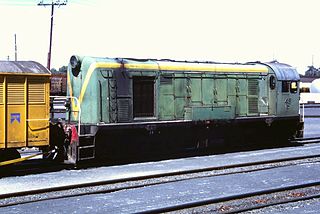Related Research Articles

The Vulcan Foundry Limited was an English locomotive builder sited at Newton-le-Willows, Lancashire.

The North British Locomotive Company was created in 1903 through the merger of three Glasgow locomotive manufacturing companies; Sharp, Stewart and Company, Neilson, Reid and Company and Dübs and Company, creating the largest locomotive manufacturing company in Europe and the British Empire and the second largest in the world after the Baldwin Locomotive Works in the United States.

The Evolution Series is a line of diesel locomotives built by GE Transportation Systems, initially designed to meet the U.S. EPA's Tier 2 locomotive emissions standards that took effect in 2005. The line is the direct successor to the GE Dash 9 Series. The first pre-production units were built in 2003. Evolution Series locomotives are equipped with either AC or DC traction motors, depending on the customer's preference. All are powered by the GE GEVO engine.

The New Zealand DI class locomotive was a class of diesel-electric locomotive in New Zealand. They were built by English Electric at their plant in Rocklea, Queensland in Australia. The class is very similar to the Queensland Railways 1620 class locomotives. At the time of their introduction, the class was seen as an alternative to the DB class for use on lightly laid secondary and branch lines, more so in the South Island. The World Bank financed introduction of the Japanese built DJ class in 1968, which ensured that no further DI class locomotives were purchased by New Zealand Railways.

The ALCO FA is a family of B-B diesel locomotives designed to haul freight trains. The locomotives were built by a partnership of ALCO and General Electric in Schenectady, New York, between January 1946 and May 1959. Designed by General Electric's Ray Patten, they were of a cab unit design; both cab-equipped lead FA and cabless booster FB models were built. A dual passenger-freight version, the FPA/FPB, was also offered. It was equipped with a steam generator for heating passenger cars.

South Australian Railways (SAR) was the statutory corporation through which the Government of South Australia built and operated railways in South Australia from 1854 until March 1978, when its non-urban railways were incorporated into Australian National, and its Adelaide urban lines were transferred to the State Transport Authority.

The Tasmanian Government Railways Y class is a class of diesel locomotives built by the Tasmanian Government Railways between 1961 and 1971.

The Victorian Railways L class was a class of electric locomotives built by English Electric and operated by the Victorian Railways and later V/Line from 1953 until 1987 primarily on the Gippsland line. They were the only class of main line electric locomotive operated in Victoria.

The GT46C is a model of diesel-electric locomotive designed and built by Clyde Engineering using Electro-Motive Diesel components. A number of Australian rail freight operators purchased them from 1997: Westrail as the Q class, FreightLink as the FQ class, and Freight Australia as the single-locomotive V class. As of 2022, all 24 locomotives were owned by Aurizon following its purchase of certain One Rail Australia assets in July 2022.

The T class are a class of diesel locomotives built by Clyde Engineering, Granville for the Victorian Railways between 1955 and 1968.

The G Class are a class of diesel locomotive built by Clyde Engineering, Rosewater and Somerton for V/Line between 1984 and 1989.

The 41 class were a class of diesel locomotives built by British Thomson-Houston in the United Kingdom for the New South Wales Department of Railways in 1953 and 1954.

The 43 class were a class of Australian diesel locomotives built by A Goninan & Co, Broadmeadow for the New South Wales Department of Railways in 1956–1957.

The S class are a class of diesel locomotives built by Clyde Engineering, Forrestfield for Westrail in 1998.

The Transnet Freight Rail Class 43-000 of 2011 is a South African diesel-electric locomotive.

The 900 class were a class of diesel locomotives built by Islington Railway Workshops for the South Australian Railways between 1951 and 1953.

The F class were a class of diesel locomotives built by English Electric, Rocklea for the Midland Railway of Western Australia in 1958. They were later sold to the Western Australian Government Railways.
The Tasmanian Government Railway Z class are a class of diesel locomotives built by English Electric, Rocklea for the Tasmanian Government Railways in 1973. They were a development of the Western Australian Government Railways R class and were the last of a line of very successful locomotives fitted with the English Electric 12CSVT Mk II engine.

The Emu Bay Railway 10 class are a class of diesel-hydraulic locomotives built by Walkers Limited, Maryborough for the Emu Bay Railway between 1963 and 1966.
The fleet of locomotives in Pakistan currently consists solely of diesel locomotives owned and operated by Pakistan Railways. Steam locomotives are no longer used in Pakistan, except in heritage trains. All locomotives are serviced at the Pakistan Locomotive Factory in Risalpur, Khyber Pakhtunkhwa.
References
- ↑ Contracts & Tenders Railway Gazette 9 January 1953 page 53
- ↑ Pakistan Order Nine Australian-Built Diesel Locos: Similar to CR Units Railway Transportation February 1953 page 25
- ↑ £1m locomotive order Daily Telegraph 27 August 1953 page 3
- ↑ Australia's First Export Order for Diesel Power to go to Pakistan Railway Transportation October 1953 page 38
- ↑ Pakistan's CLP15 Class Locomotives Newsrail August 2014 pages 236-238